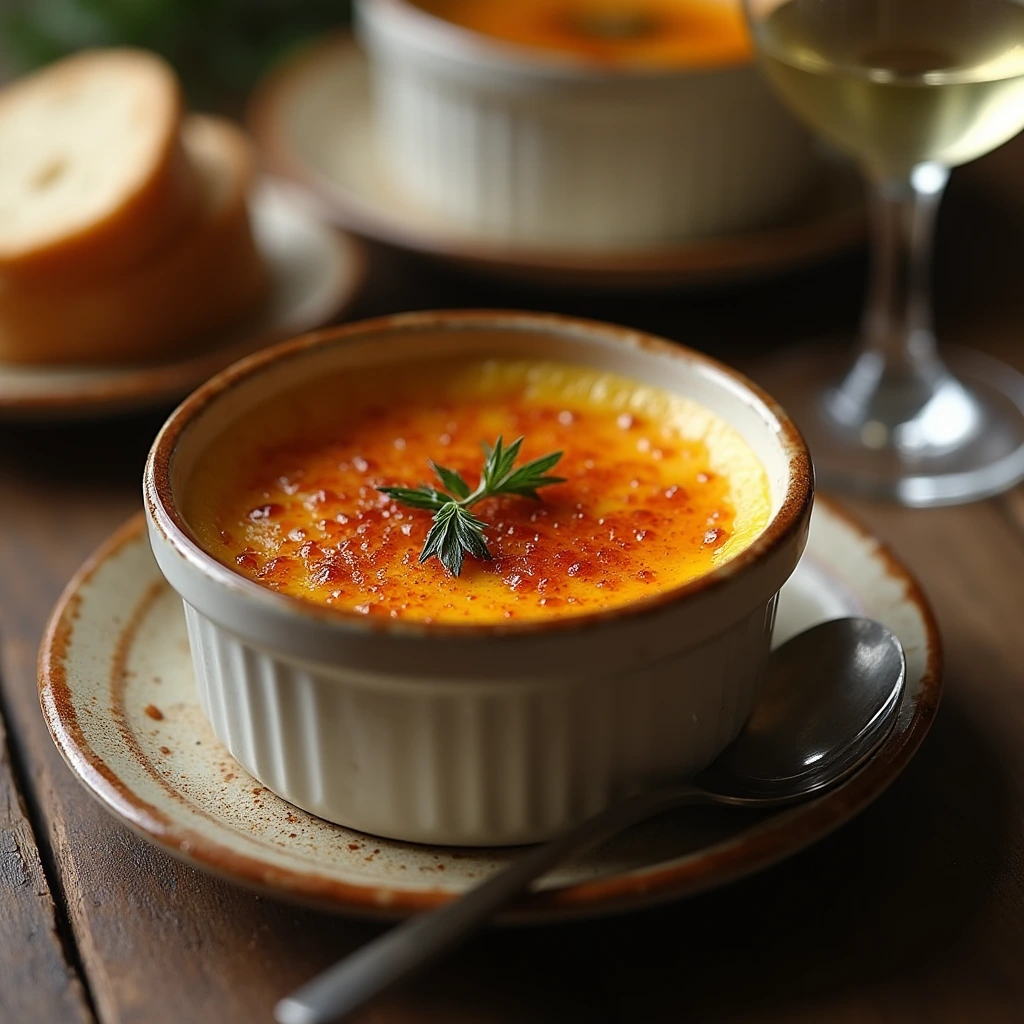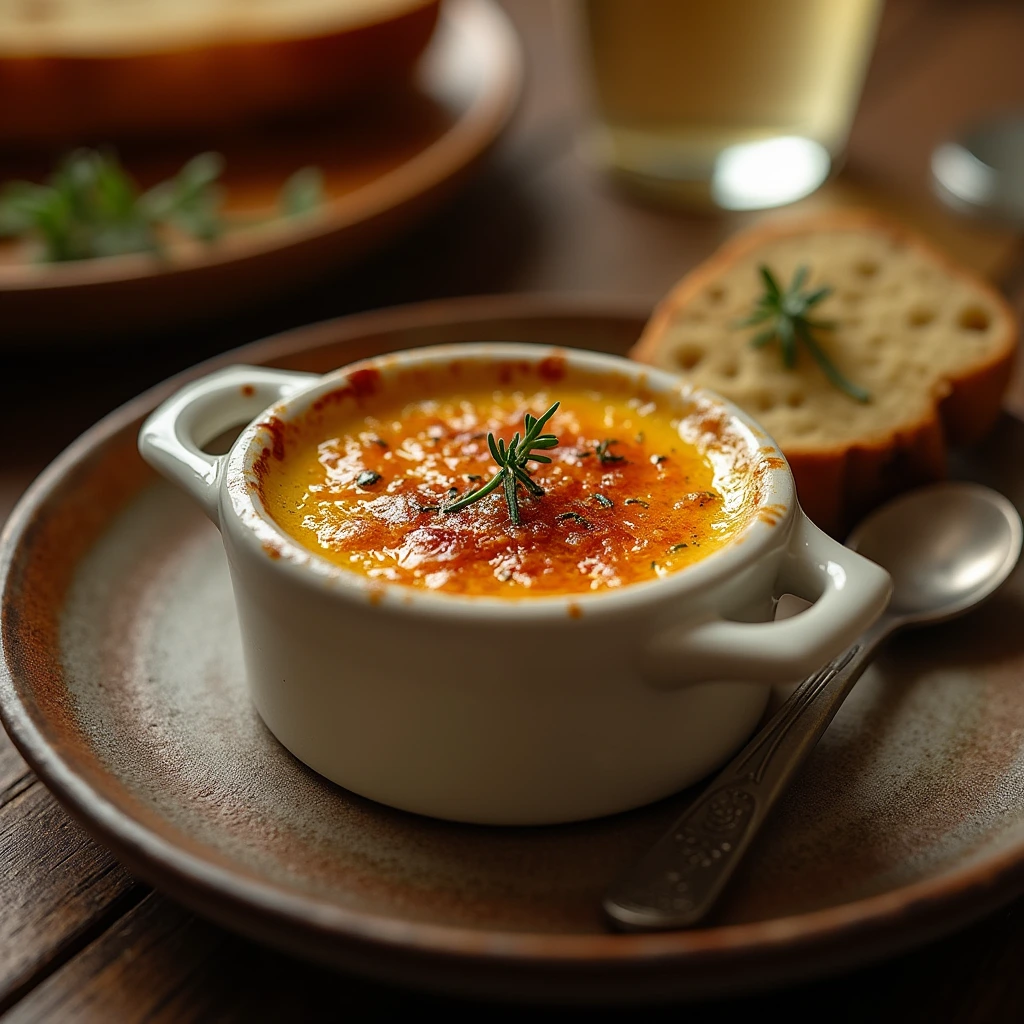When you think of brûlée, you might picture the classic dessert – crème brûlée, a sweet custard with a caramelized sugar top. However, chefs have reinvented this dish as savoury brulee, mixing creamy textures with bold, salty, and rich flavors to create a one-of-a-kind treat.
This dish shows the creativity of modern cooking, turning a familiar dessert into something new. Whether served as a starter, a side, or the main course, savoury brûlée brings together elegance and comfort. In this guide, we’ll look at its history, ingredients, and how to make it. Get ready to enjoy a dish that looks as good as it tastes.

Understanding Savoury Brulee
Origins and Inspiration
The savoury brulee comes from the classic crème brûlée, a dessert loved for its creamy texture and caramelized top. Over time, chefs reworked this dessert into a savory dish, adding bold flavors. They wanted to combine creamy textures with salty and rich ingredients, creating a dish that feels both fancy and comforting. Because of this, savoury brûlée has become popular in restaurants and home kitchens, showing how flexible and appealing it can be.
Key Ingredients
A savoury brulee starts with a creamy base, often made with cream, cheese, or egg yolks. Chefs then add simple ingredients like herbs, garlic, or bacon to boost the flavor. To finish, they caramelize a sugar layer or add a crispy topping to create the classic texture. Many variations exist, such as using smoked salmon, roasted vegetables, or truffle oil. This makes it easy to adjust the dish for different tastes.
Popular Varieties of Savoury Brulee
Cheese-Based Brûlées
Cheese often takes center stage in savoury brulees, as it provides rich, creamy, and indulgent flavors. For instance, varieties like Gruyère, Parmesan, and aged cheddar are commonly used because of their bold tastes and smooth melting properties. Additionally, these brûlées work well as appetizers or elegant sides to a main dish. Furthermore, a crispy caramelized topping adds the perfect contrast to the creamy, cheesy interior, making this variety a favorite among cheese enthusiasts.
Vegetable-Focused Brûlées
For those seeking lighter options, vegetable-focused savoury brulees are an excellent choice. Ingredients such as roasted bell peppers, caramelized onions, spinach, or butternut squash often serve as the base for these creations. Moreover, these versions are not only flavorful but also visually appealing due to their vibrant colors. The natural sweetness of the vegetables pairs beautifully with the savory brûlée crust, offering a healthy yet indulgent treat. As a result, these brûlées are perfect for those looking to balance taste with nutrition.
Protein-Infused Brûlées
Protein-based savoury brulees elevate this dish to a more satisfying and hearty meal. For example, options such as smoked salmon, crab, chicken, or duck infuse the brûlée with robust and satisfying flavors. Consequently, these brûlées are ideal as a main course or a sophisticated starter. The protein blends seamlessly with the creamy base, while the caramelized top provides a delightful crunch. Therefore, this variety is a gourmet masterpiece that satisfies both flavor and texture enthusiasts.
The Science of Bruleeing
The Role of Sugar in Savoury Dishes
While sugar is typically associated with desserts, it plays a critical role in savoury brulees. In small amounts, sugar balances and enhances the savory flavors of the dish. For example, it highlights the richness of ingredients like cheese or proteins without overpowering their natural taste. Additionally, sugar aids in creating the signature caramelized crust, which provides a contrasting sweetness and crunch to the creamy base. This subtle interplay between sweet and savory elevates the overall flavor profile, making the dish both complex and harmonious.
Creating the Perfect Caramelized Topping
Achieving the ideal caramelized topping requires a delicate balance of technique and timing. First, a thin, even layer of sugar is sprinkled over the surface of the brûlée. Then, heat is applied, usually with a culinary torch, to melt and caramelize the sugar. The heat causes the sugar molecules to break down and transform into a golden, crispy crust. It’s essential to control the torch’s movement to avoid burning the sugar, as burnt flavors can overpower the dish. Furthermore, letting the brûlée cool for a minute after caramelizing ensures the topping hardens properly, resulting in the perfect crack with every bite.
Step-by-Step Guide to Making Savoury Brulee
Essential Tools and Ingredients
Before starting, gather the necessary tools and ingredients to ensure a smooth cooking process.
Tools:
- Ramekins: Small, heat-resistant dishes for individual servings.
- Culinary torch: Essential for caramelizing the topping.
- Mixing bowls: For preparing the custard base.
- Whisk: To blend ingredients thoroughly.
- Baking dish: For a water bath to ensure even cooking.
- Sieve: To strain the custard for a smooth texture.
Ingredients:
- Cream or milk: Provides the base for the custard.
- Egg yolks: Adds richness and helps the custard set.
- Savory flavorings: Choose cheese, garlic, herbs, or proteins like smoked salmon or crab.
- Sugar: For creating the caramelized topping.
- Salt and pepper: To enhance the savory flavors.
Detailed Recipe Process
1: Prepare the Custard Base
- Preheat the oven to 300°F (150°C).
- In a saucepan, heat cream or milk until warm but not boiling.
- In a mixing bowl, whisk egg yolks with a pinch of salt and pepper.
- Gradually add the warm cream to the egg mixture, whisking constantly to avoid curdling.
- Stir in your chosen savory ingredients, such as grated cheese, herbs, or protein.
2: Assemble and Bake
- Strain the custard through a sieve to remove any lumps, ensuring a smooth texture.
- Pour the mixture evenly into ramekins.
- Place the ramekins in a baking dish, then fill the dish with hot water until it reaches halfway up the sides of the ramekins.
- Bake for 30–40 minutes, or until the custard is just set but still slightly wobbly in the center.
- Remove the ramekins from the water bath and let them cool to room temperature, then refrigerate for at least an hour.
3: Caramelize the Topping
- Sprinkle an even layer of sugar over the top of each custard.
- Use a culinary torch to melt the sugar, moving it in a circular motion for even caramelization.
- Allow the topping to cool and harden for a minute before serving.
4: Serve and Enjoy
Serve the savoury brulee as an appetizer, side dish, or main course. Pair it with a fresh salad or crusty bread for a complete and elegant meal.
Tips and Tricks for Perfecting Savoury Brulee
Common Mistakes to Avoid
- Overcooking the Custard:
Overcooked custard becomes grainy and loses its creamy texture. To avoid this, bake the brûlée until it is just set and still slightly wobbly in the center. - Skipping the Water Bath:
A water bath is essential because it ensures even cooking and prevents the custard from cracking. Always place your ramekins in a baking dish filled with hot water before baking. - Uneven Sugar Layer:
An uneven sugar topping can lead to burnt spots or incomplete caramelization. Therefore, make sure to sprinkle a thin, uniform layer of sugar for consistent results. - Burning the Sugar:
Holding the culinary torch too close or staying in one spot for too long often burns the sugar. Instead, move the torch in small, circular motions to achieve even caramelization. - Using Cold Ingredients:
Cold cream or eggs can result in a lumpy custard. Thus, it’s important to use room-temperature ingredients for a smooth mixture.
Enhancing Flavor Profiles
- Experiment with Herbs and Spices:
To add complexity, include fresh herbs like thyme, rosemary, or chives. Additionally, a touch of nutmeg or smoked paprika can deepen the flavor and elevate the dish. - Incorporate High-Quality Cheeses:
For a bold and sophisticated taste, choose flavorful cheeses such as Gruyère, Parmesan, or blue cheese. Furthermore, these cheeses melt well, creating a luxurious texture. - Layer Flavors with Proteins:
Adding ingredients like smoked salmon, prosciutto, or crab not only enhances richness but also introduces a delightful texture. As a result, the brûlée feels more substantial and indulgent. - Balance Sweet and Savory:
If you use sugar for the topping, it’s crucial to season the savory base well. This contrast creates a harmonious blend of flavors, making the dish more enjoyable. - Add a Crunchy Garnish:
For an extra layer of texture, consider crispy toppings like breadcrumbs, fried onions, or toasted nuts. Moreover, these garnishes provide a visual appeal that enhances the dish’s presentation.
Pairing Savoury Brulee with Other Dishes
Complementary Sides
Choosing the right sides can make savoury brulee even better. For example, fresh salads with leafy greens, cherry tomatoes, and a light dressing bring a refreshing balance to the rich brûlée. You could also serve roasted vegetables like asparagus, carrots, or brussels sprouts, which add a mild, earthy flavor.
For something more filling, crusty bread or garlic toast works well. These sides add texture and let guests scoop up the creamy custard. Grains like quinoa or wild rice can also be a good match, as their nutty taste goes well with the savory flavors. By adding sides with different textures and flavors, you create a meal that feels complete and satisfying.
Beverage Pairings
Picking the right drink can bring out the best in savoury brulee. A crisp white wine, like Sauvignon Blanc or Chardonnay, pairs well because its slight acidity cuts through the richness. If you like red wine, try a light option like Pinot Noir, which adds a gentle fruitiness to match the savory taste.
For non-alcoholic choices, sparkling water with lemon or lime can be a great option. Herbal teas, such as chamomile or mint, also offer a calming balance. For something different, a light beer or craft cider works nicely by highlighting the dish’s savory flavors.
By carefully choosing sides and drinks, you can turn savoury brulee into a star dish that shines with its pairings.
FAQs
What does “brûlée” mean in cooking?
In cooking, “brûlée” is a French word that means “burnt.” It refers to the process of caramelizing sugar on the surface of a dish, creating a thin, crispy layer. This technique is most commonly associated with desserts like crème brûlée but can also be used in savoury dishes for added texture and flavor contrast.
What’s the difference between a souffle and a brûlée?
A soufflé is a light, airy dish made by folding whipped egg whites into a base mixture, often baked until it puffs up. In contrast, a brûlée, such as crème brûlée or savoury brulee, is a creamy custard dish with a caramelized sugar topping. While soufflés are known for their fluffy texture, brûlées emphasize the contrast between the smooth custard and the crisp topping.
What flavor is brûlée?
The flavor of a brûlée depends on its ingredients. The caramelized sugar topping adds a rich, slightly bitter sweetness, while the base can range from vanilla and cream in desserts to savory ingredients like cheese, herbs, or seafood. The contrast between the topping and the base creates a balanced, multidimensional taste.
What’s the difference between crème brûlée and custard?
Crème brûlée is a specific type of custard that includes a caramelized sugar topping. While all crème brûlée is custard, not all custard is crème brûlée. Custards are smooth, creamy mixtures of milk or cream, egg yolks, and sugar, often baked or cooked until thickened. Crème brûlée takes it a step further by adding the signature brûléed crust.
Final Thoughts on Savoury Brulee
Savoury brulee is more than just a creative twist on a classic dessert – it’s a culinary innovation that blends elegance with bold flavors. This versatile dish can be tailored to suit any occasion, whether as an appetizer, a side, or a main course. Its creamy base, paired with a crispy caramelized topping, creates a delightful balance of textures and flavors that never fails to impress.
By experimenting with different ingredients and pairing options, you can make savoury brulee a signature dish in your kitchen. From cheese-based variations to protein-infused creations, this dish offers endless opportunities to showcase your creativity. Ultimately, savoury brulee is a testament to how traditional techniques can be reimagined to create something truly unique and delicious.
More
For additional insights into culinary delights and related recipes, Quickly Taste offers a treasure trove of resources. Start with their Jif Peanut Butter Cookie Recipe for a sweet treat that’s perfect for any occasion. If you’re exploring savory options, the Frank’s Buffalo Chicken Dip Recipe delivers bold and tangy flavors that are great for gatherings. For those intrigued by caramelized dishes, the How to Make Brûlée Topping guide is an essential read, offering tips on achieving the perfect sugary crust.
For external inspiration, consider browsing the official Sitemaps.org to understand how XML sitemaps like the one used by Quickly Taste enhance site navigation and searchability. Additionally, culinary enthusiasts might enjoy exploring Serious Eats, a well-known resource for detailed recipes and cooking techniques.
These resources, both internal and external, provide a mix of recipes, techniques, and technical insights, helping you master your next cooking adventure.

